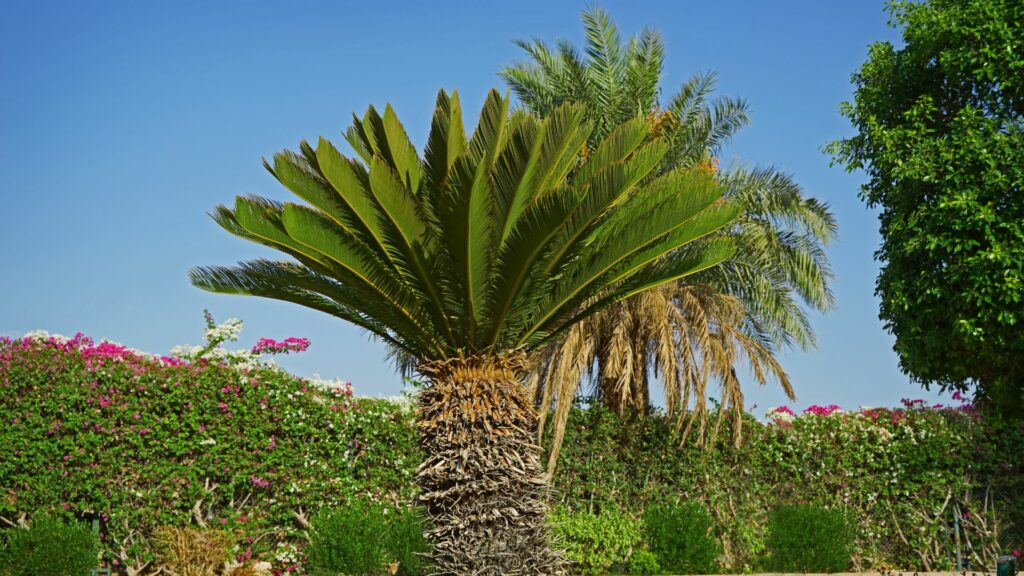For centuries, palm trees, easily identifiable by their single trunk and cluster of imposing top leaves, have been globally revered for their unmistakable, majestic, and tropical addition to any landscape. Palm trees are strongly associated with exotic holiday destinations and tropical utopias as they thrive in warm, moist, and humid conditions. Providing your palm with sufficient nutrition is critical to its survival.
The optimal nutrition regimen and fertilizer for palm trees significantly varies throughout the incredibly diverse Aceraceae plant family. Understanding your palm’s nutritional needs, its ideal type of fertilizer, and exactly when it must be nourished will maintain its lush and iconic appearance.
Most trusted industry experts agree that selecting a palm’s fertilizer is an essential first step concerning the tree’s long-term and customized nutritional regime. However, having a comprehensive understanding of the palm’s fertilization and nourishment requirements is essential while ensuring they are applied at the correct time in appropriate quantities will enhance its vibrance, health, and longevity.
What is the Best Fertilizer for Palm Trees?

Choosing and buying the most appropriate fertilizer for any palm tree is the most influential step concerning its comprehensive nutrition schedule process.
While selecting the best fertilizer for any tree’s nutritional requirements is critical, palm trees’ daily needs are unique, making the initial purchasing decision significantly more challenging, stressful, and expensive.
Suppose you do not have decades of experience nurturing, maintaining, and refining aesthetically appealing palms. In that case, it is recommended that you thoroughly research your trees’ specific needs, as they are known to vary dramatically among the more than 2,500 distinct species.
Despite being overwhelming to some first-time buyers, there are five key factors to methodically consider before making the incredibly important purchasing decision:
Nitrogen, Phosphorus, and Potassium (NPK) Ratio
Experts suggest searching for a fertilizer with an appropriately balanced nitrogen, phosphorus, and potassium ratio. While the ratio best suited for your palm tree’s nutritional requirements will differ, the optimal ratio accepted throughout the industry is 12-4-12 or 8-2-12.
Suppose you can purchase a fertilizer with an appropriate ratio, combined with beneficial micronutrients such as manganese, magnesium, and iron. Any additional micronutrients combined with the initial NPK ratio will undoubtedly enhance your palm tree’s authentic allure, appeal, distinct exotic image, and longevity will be dramatically enhanced.
Controlled or Slow-Release Formulation
Palm tree fertilizers can usually be purchased in alternative timed-release forms. The most popular option for palm trees globally remains the controlled-release or slow-release fertilizer type. These fertilizers will slowly and in a thoroughly controlled manner, apply sufficient nutrients to your palms over a lengthened time.
Despite the tedious yet controlled method of nutrient release seeming counterintuitive to most inexperienced individuals, the process ensures most of the negative outcomes associated with rapid or over-fertilization practices are eliminated, allowing the tree to steadily and naturally grow as it would in its naturally tropical habitats.
Synthetic or Organic
Numerous suitable synthetic and organic palm tree fertilizers are available to customers worldwide. Fortunately, in most cases, you can buy a synthetic or organic option without incurring any notable side effects or negative impacts. Modern synthetic fertilizers are designed to induce a rapid and beneficial nutrient boost.
Organic palm tree fertilizers cannot induce the same concentration of nutrients since it has not experienced any form of scientific genetic modification. However, organic fertilizers significantly improve the soil’s overall health, directly, naturally, and permanently benefiting countless vulnerable palm trees.
Precise Micronutrient Content
It is critical to double-check your chosen fertilizer’s micronutrient content. Despite being overlooked and underrated by many palm tree care experts over the last 50 years, naturally occurring micronutrients such as manganese and magnesium are directly linked with assisting palm’s distinct and unsurpassed green foliage and healthy frond growth.
Granular or Water-Soluble
The choice between water-soluble and granular palm tree fertilizers is not as consequential as the factors mentioned above; however, it must be noted that granular options are additionally practical, convenient, slower releasing, and cost-effective.
Conversely, water-soluble fertilizers are markedly faster at applying the required palm tree nutrients, although they require regular applications, consistent monitoring, and heightened stress.
When to Fertilize Palm Trees
The timing of fertilizing your palm trees is exceedingly critical as this is the only way to guarantee they receive sufficient nutrients at exactly the right time.
Applying fertilizer and nutrients to any living plant is undoubtedly important. Yet, the importance is heightened for most palm trees located far from their traditional habitats, tropical climates, and consistently moist weather conditions.
Countless unexpected occurrences can influence the timing of fertilizing palm trees, although several unavoidable factors are solely responsible for their longevity and positive outcomes.
While successfully timing your trees’ fertilization is incredibly challenging and can rapidly lead to unnecessary disasters, consistently accounting for several fundamental factors will reduce the risk of negative outcomes to zero.
Growing Season and Frequency
The optimal time to fertilize your palm trees, providing sufficient nutrients at the right time, is throughout their dynamic growing season.
The growing season traditionally occurs between the spring and initial stages of the summer months. It is not recommended to apply fertilizer to your palm trees during the later parts of fall or winter as the tree is in its yearly dormant period.
A common issue among palm tree carers is the overutilization of fertilizers, negatively impacting its long-term outcomes and wasting precious financial resources. Usually, a thorough fertilization period during the spring is adequate. Younger or developing trees must receive appropriate fertilizers more frequently as the process offers numerous advantages in its critical development phase.
Extreme Heat and Soil Analysis
Avoiding any form of fertilization during the extreme temperatures of the summer months or similar heatwave-type events is advisable, removing as much of the palm’s induced stress and potential harm as possible.
At the same time, implementing a thorough, well-researched, and well-planned soil test will allow you to accurately identify any lacking nutrients. While it is not essential to test and analyze the palm trees’ soil, it helps in the applicable customization of an individual fertilization schedule and nutritional blend ratio.
Final Thoughts
Fertilizing, nourishing, and caring for millions of idyllic-looking palm trees globally is an incredibly daunting process to everyone not considered a long-time industry expert.
Despite the unavoidable complexities linked with the positive development of palm trees and their never-ending nutritional needs, selecting an optimal fertilizer, appropriately applying it, and timing it correctly will ensure your palms retain their health and vibrance while positively impacting the surrounding landscapes’ splendor.

